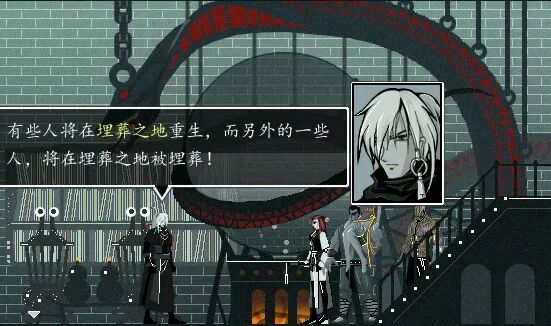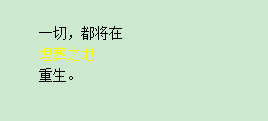tdd方式编写游戏中彩色文本
本项目来自https://gitee.com/valuetodays/tdd_rpg_dialog_color_text。
它是一个简单项目,用以展示使用tdd(test driven development)方式完成一个需求的过程。
工具
- gradle
- junit4
- jacoco
缘由
为什么会有本项目?因为我之前用java写过一个rpg,见https://gitee.com/valuetodays/rpg-one。里面就有显示彩色对话文本的功能,这个功能比较独立,这几天又看到了tdd,又想使用一下gradle,所以该项目就出现了。
目标
对代码编程者:通过使用tdd,来快乐地编程。 对代码阅读者:不借助最终的源码库,一步步手工编写或复制代码来完成本项目。
准备
雨血是我非常喜欢的一部武侠rpg。下面我将会以它其中的两句台词截图来完成我们的项目。


PS:台词内容(二者并不是对话关系)是:
一切,都将在埋葬之地重生。
有些人将在埋葬之地重生,而另外的一些人,将在埋葬之地被埋葬!
从截图上可以看到,一行显示18个汉字。
下面我们就开始一步一步地把对话文本分割成一行行彩色对话。
第一步:创建测试骨架
我们先定义一个接口DialogTextFormatter。它有一个format方法,参数是一个字符串。
本项目中使用的类的包名都是billy.rpg.common.formatter,如下不再重复说明。
package billy.rpg.common.formatter;
import java.util.List;
public interface DialogTextFormatter {
List<String> format(String text);
}
接着,我们就可以编写测试类了。从面向对象角度来说DialogTextFormatter应该有个默认的实现类,名叫DefaultDialogTextFormatter。
package billy.rpg.common.formatter;
import java.util.List;
public class DefaultDialogTextFormatter implements DialogTextFormatter {
@Override
public List<String> format(String text) {
return null;
}
}
那我们的测试类的名称就是DefaultDialogTextFormatterTest。我们使用的测试骨架如下(以后都是往该测试类里添加方法):
package billy.rpg.common.formatter;
import org.junit.Before;
import org.junit.Test;
public class DefaultDialogTextFormatterTest {
private DialogTextFormatter dialogTextFormatter;
@Before
public void before() {
dialogTextFormatter = new DefaultDialogTextFormatter();
}
}
第二步:显示简单对话文本
我们的目标是展示出如下对话:

它的特点是对话文本会换行,里面会有些文本是彩色。 好了,下面一起开始吧。
我们要显示一段简单的文本,效果图如下:

如下我们将在DefaultDialogTextFormatterTest类中添加第一个测试方法。
@Test
public void testFormatWithSingleLine() {
String text = "一切,都将在埋葬之地重生。";
List<String> resultList = dialogTextFormatter.format(text);
assertNotNull(resultList);
assertThat(resultList.size(), is(1));
assertThat(resultList.get(0), is(text));
}
我们传入一个简单的文本,期望dialogTextFormatter返回一个List类型的resultList,期望它的大小是1,期望它的第一个值是传入的参数。 那么,执行该测试方法!
不出意外,断言没能通过,出现了红条。当然了,因为我们还没有编写实现方法,如下
@Override
public List<String> format(String text) {
List<String> result = new ArrayList<>();
result.add(text);
return result;
}
可以看到实现方法非常简单,这也是tdd的核心,每次实现都以最小的代码来让测试通过。
运行测试类,或使用命令行gradle clean test,然后去build/reports/tests/test下打开index.html,看下测试成功率。
目前我们只有一个方法,它执行成功了,所以成功率就是100%。
我们还需要看测试覆盖率,执行gradle clean test jacocoTestReport然后去build/reports/jacoco/test/html下访问index.html,可以看到每个方法的覆盖率情况。
以后我们每编写一点功能就得不断地执行测试类来确保新功能没有影响到旧功能,或修改旧测试方法以适应新功能。
第三步:显示简单长对话文本
上步我们展示了一个简单的文本,这步我们要往目标迈近一步——展示换行的文本。
目标效果图如下:

想要展示换行文本,我们需要定一个变量,每行显示文字数量,即wordsNumPerLine,它是DefaultDialogTextFormatter的一个属性, 该值应该由外部传入,所以为DefaultDialogTextFormatter添加构造方法并传入此值。
(为什么不在DefaultDialogTextFormatter内部直接定义一个静态常量呢,因为只要定义了常量,类与数值就绑定了,我们要做的是解耦,所以要传入)
我们在DefaultDialogTextFormatterTest内部定义一个静态常量WORDS_NUM_PER_LINE,用以设置每行显示文字数量,上面说过了,它的值是18。
private final static int WORDS_NUM_PER_LINE = 18;
然后我们的测试方法应该如下:
@Test
public void testFormatWithMultiLine() {
String text = "有些人将在埋葬之地重生,而另外的一些人,将在埋葬之地被埋葬!";
List<String> resultList = dialogTextFormatter.format(text);
assertNotNull(resultList);
assertThat(resultList.size(), is(2));
assertThat(resultList.get(0), is(text.substring(0, WORDS_NUM_PER_LINE)));
assertThat(resultList.get(1), is(text.substring(WORDS_NUM_PER_LINE)));
}
此时我们应该在before()方法中将WORDS_NUM_PER_LINE传给DefaultDialogTextFormatter,修改后的before()方法如下:
@Before
public void before() {
dialogTextFormatter = new DefaultDialogTextFormatter(WORDS_NUM_PER_LINE);
}
这时DefaultDialogTextFormatter类会报错。我们在DefaultDialogTextFormatter类中添加如下内容
private int wordsNumPerLine;
public DefaultDialogTextFormatter(int wordsNumPerLine) {
this.wordsNumPerLine = wordsNumPerLine;
}
代码编译正常后,我们执行新写的测试方法testFormatWithMultiLine()。 又是红条。 我们就修改实现方法,实现方法不只一种,我的策略是从第一个字符开始,每次取wordsNumPerLine字,不足字数就说明到了文本的末尾了。
修改后的format()如下:
@Override
public List<String> format(String text) {
List<String> result = new ArrayList<>();
int start = 0;
int end = wordsNumPerLine;
while (start < text.length()) {
if (text.length() < end) {
end = text.length();
}
String lineText = text.substring(start, end);
result.add(lineText);
start = end;
end = start + wordsNumPerLine;
}
return result;
}
第四步:显示简单对话文本(含颜色)
上步我们实现了文本的换行,这次我们要在单行文本的基础上,添加颜色功能。
目标效果如下:

这次我们发现format()方法的返回值是List,不足以存放颜色字段。我们需要添加一个类DialogFormattedText作为返回的对象。
package billy.rpg.common.formatter;
import java.awt.*;
public class DialogFormattedText {
private final String content;
private final Color color;
public DialogFormattedText(String content, Color color) {
this.content = content;
this.color = color;
}
public String getContent() {
return content;
}
public Color getColor() {
return color;
}
@Override
public String toString() {
return content + "@(" + color.getRed() + "," + color.getGreen() + "," + color.getBlue() + ")";
}
}
注意要将DialogTextFormatter的format()方法要由原来的
List<String> format(String text);
改为
List<DialogFormattedText> format(String text);
这时会有编译错误,我们要改动的内容还真不少。
DefaultDialogTextFormatter类中result的类型要从
List<String> result = new ArrayList<>();
改为
List<DialogFormattedText> result = new ArrayList<>();
对result添加数据的操作也要从
result.add(new DialogFormattedText(lineText, Color.BLACK));
改为
result.add(new DialogFormattedText(lineText, Color.BLACK));
之前的两个测试类也相应在修改为
@Test
public void testFormatWithSingleLine() {
String text = "一切,都将在埋葬之地重生。";
List<DialogFormattedText> resultList = dialogTextFormatter.format(text);
assertNotNull(resultList);
assertThat(resultList.size(), is(1));
assertThat(resultList.get(0).getContent(), is(text));
}
和
@Test
public void testFormatWithMultiLine() {
String text = "有些人将在埋葬之地重生,而另外的一些人,将在埋葬之地被埋葬!";
List<DialogFormattedText> resultList = dialogTextFormatter.format(text);
assertNotNull(resultList);
assertThat(resultList.size(), is(2));
assertThat(resultList.get(0).getContent(), is(text.substring(0, WORDS_NUM_PER_LINE)));
assertThat(resultList.get(1).getContent(), is(text.substring(WORDS_NUM_PER_LINE)));
}
同时,用于简单显示的debug()方法也应该有相应的变动。
private void debug(List<DialogFormattedText> resultList) {
for (DialogFormattedText dialogFormattedText : resultList) {
logger.debug(dialogFormattedText);
}
}
下面该说文本中含有颜色的事了,我们使用标签如来表示红色,来表示绿色,表示黄色,表示蓝色。
再贴下本步的目标图

这样,我们的文本应该是一切,都将在<y>埋葬之地</y>重生。
测试方法如下:
@Test
public void testFormatWithColorSingleLine() {
String text = "一切,都将在<y>埋葬之地</y>重生。";
List<DialogFormattedText> resultList = dialogTextFormatter.format(text);
assertNotNull(resultList);
assertThat(resultList.size(), is(3));
assertThat(resultList.get(0).getContent(), is("一切,都将在"));
assertThat(resultList.get(0).getColor(), is(Color.BLACK));
assertThat(resultList.get(1).getContent(), is("埋葬之地"));
assertThat(resultList.get(1).getColor(), is(Color.YELLOW));
assertThat(resultList.get(2).getContent(), is("重生。"));
assertThat(resultList.get(2).getColor(), is(Color.BLACK));
}
执行测试类,失败,下面开始编写实现方法。format()方法如下:
public List<DialogFormattedText> format(String text) {
List<DialogFormattedText> textListWithColor = processColorTag(text);
return textListWithColor;
}
添加processColorTag()方法如下:
private List<DialogFormattedText> processColorTag(String msg) {
List<DialogFormattedText> msgListTemp = new ArrayList<>();
String msgTemp = msg;
while (true) {
int colorTagPos = msgTemp.indexOf('<');
if (colorTagPos == -1) {
break;
}
String tagBegin = msgTemp.substring(colorTagPos, colorTagPos + "<c>".length());
int indexOf = msgTemp.indexOf(tagBegin);
String bef = msgTemp.substring(0, indexOf);
msgListTemp.add(new DialogFormattedText(bef, Color.BLACK));
String tagEnd = tagBegin.substring(0, 1) + "/" + tagBegin.substring(1);
int indexOf2 = msgTemp.indexOf(tagEnd, indexOf);
if (indexOf2 < 0) {
throw new RuntimeException("unclose tag found!");
}
String coloredMsg = msgTemp.substring(indexOf + tagBegin.length(), indexOf2);
Color color = getColor(tagBegin);
msgListTemp.add(new DialogFormattedText(coloredMsg, color));
msgTemp = msgTemp.substring(indexOf2 + tagEnd.length());
}
msgListTemp.add(new DialogFormattedText(msgTemp, Color.BLACK));
return msgListTemp;
}
private Color getColor(String tagName) {
char flagName = tagName.toLowerCase().charAt(1);
if ('r' == flagName) {
return Color.red;
}
if ('b' == flagName) {
return Color.blue;
}
if ('g' == flagName) {
return Color.green;
}
if ('y' == flagName) {
return Color.yellow;
}
return Color.BLACK;
}
执行新写的测试方法testFormatWithColorSingleLine(),正常。但是testFormatWithMultiLine()方法则断言失败了。 下一步我们就修复这个问题。
第五步:处理过后的彩色文本过长
上步我们完成了单行彩色文本,但是遗留了一下问题,就是处理过颜色标签的一行文本超过了WORDS_NUM_PER_LINE。
修改后format()方法如下:
public List<DialogFormattedText> format(String text) {
List<DialogFormattedText> textListWithColor = processColorTag(text);
List<DialogFormattedText> formattedTextListWithColor = processColorText(textListWithColor);
return formattedTextListWithColor;
其中processColorText()方法如下:
private List<DialogFormattedText> processColorText(
List<DialogFormattedText> textListWithColor) {
List<DialogFormattedText> processedColorMsgList = new ArrayList<>();
for (DialogFormattedText textWithColor : textListWithColor) {
String content = textWithColor.getContent();
Color color = textWithColor.getColor();
int start = 0;
int end = start + wordsNumPerLine;
while (start < content.length()) {
if (content.length() < end) {
end = content.length();
}
String lineText = content.substring(start, end);
processedColorMsgList.add(new DialogFormattedText(lineText, color));
start = end;
end = start + wordsNumPerLine;
}
}
return processedColorMsgList;
}
这时,现有的三个测试方法都已正常运行。
第6步:真实的换行
上步我们完成了彩色文本换行的处理,但是它们没有真的换行!
理论上说,一行文本没有超过WORDS_NUM_PER_LINE,它们就应该在一行,而上一步我们的处理结果却是三条
String text = "一切,都将在<y>埋葬之地</y>重生。";
List<DialogFormattedText> resultList = dialogTextFormatter.format(text);
assertNotNull(resultList);
assertThat(resultList.size(), is(3));
所以说,resultList的长度与换不换行没有关系。

我们缺少文本坐标的概念。 如上testFormatWithColorSingleLine()测试方法返回的值符合预期,但展示起来的话,它可能长这个样子,

而非我们的真正意图:

我们应该判断出什么时候该换行了。
如下文本
"一切,都将在<y>埋葬之地</y>重生。"
应该显示在一行内。而
有些人将在<y>埋葬之地</y>重生,而另外的一些人,将在埋葬之地被埋葬!
这句文本,应该显示成如下才错正常

我们的逻辑如下: 第一部分是“有些人将在”,5个字,默认颜色 第二部分是“埋葬之地”,4个字,黄色 第三部分是“重生,而另外的一些人,将在埋葬之地被埋葬!”,但实际上第一部分和第二部分已经占用了9个字了,因为WORDS_NUM_PER_LINE的缘故,第三部分只能是9个字,所以第三部分只能是“重生,而另外的一些”, 9个字,默认颜色 第四部分是“人,将在埋葬之地被埋葬!”,9个字,默认颜色
为了达到预期,我们编写了如下测试方法。
@Test
public void testFormatWithColorMultiLine() {
String text = "有些人将在<y>埋葬之地</y>重生,而另外的一些人,将在埋葬之地被埋葬!";
List<DialogFormattedText> resultList = dialogTextFormatter.format(text);
assertNotNull(resultList);
assertThat(resultList.size(), is(4));
assertThat(resultList.get(0).getContent(), is("有些人将在"));
assertThat(resultList.get(0).getColor(), is(Color.BLACK));
assertThat(resultList.get(1).getContent(), is("埋葬之地"));
assertThat(resultList.get(1).getColor(), is(Color.YELLOW));
assertThat(resultList.get(2).getContent(), is("重生,而另外的一些"));
assertThat(resultList.get(2).getColor(), is(Color.BLACK));
assertThat(resultList.get(3).getContent(), is("人,将在埋葬之地被埋葬!"));
assertThat(resultList.get(3).getColor(), is(Color.BLACK));
}
最终的processColorText()方法如下:
private List<DialogFormattedText> processColorText(
List<DialogFormattedText> textListWithColor) {
List<DialogFormattedText> processedColorMsgList = new ArrayList<>();
int currentOffset = 0;
for (DialogFormattedText textWithColor : textListWithColor) {
String content = textWithColor.getContent();
Color color = textWithColor.getColor();
int cnt = content.length();
if (currentOffset + cnt > wordsNumPerLine) {
int start = 0;
int end = wordsNumPerLine - currentOffset;
currentOffset = 0;
while (start < content.length()) {
if (content.length() < end) {
end = content.length();
currentOffset = end - start;
}
String lineText = content.substring(start, end);
processedColorMsgList.add(new DialogFormattedText(lineText, color));
start = end;
end = start + wordsNumPerLine;
}
} else {
processedColorMsgList.add(new DialogFormattedText(content, color));
currentOffset += cnt;
}
}
return processedColorMsgList;
}
执行所有测试方法,通过。
第7步:再谈换行
上步完成的需求可以说都解决了。但,还是感觉有点奇怪,尤其是换行这一块,再看一下上步的结果图

如果我们能在“有些人在”和“人,将在埋葬之地被埋葬!”这两行前面添加一个空行来表示这里要换行了,岂不更妙?
我们先在DialogFormattedText类中添加一个静态常量
public static final DialogFormattedText NEW_LINE = new DialogFormattedText(null, Color.WHITE);
用以标识换行。
相应地,测试方法testFormatWithColorMultiLine()变动为:
@Test
public void testFormatWithColorMultiLine() {
String text = "有些人将在<y>埋葬之地</y>重生,而另外的一些人,将在埋葬之地被埋葬!";
List<DialogFormattedText> resultList = dialogTextFormatter.format(text);
assertNotNull(resultList);
assertThat(resultList.size(), is(6));
assertThat(resultList.get(0).getContent(), nullValue());
assertThat(resultList.get(1).getContent(), is("有些人将在"));
assertThat(resultList.get(1).getColor(), is(Color.BLACK));
assertThat(resultList.get(2).getContent(), is("埋葬之地"));
assertThat(resultList.get(2).getColor(), is(Color.YELLOW));
assertThat(resultList.get(3).getContent(), is("重生,而另外的一些"));
assertThat(resultList.get(3).getColor(), is(Color.BLACK));
assertThat(resultList.get(4).getContent(), nullValue());
assertThat(resultList.get(5).getContent(), is("人,将在埋葬之地被埋葬!"));
assertThat(resultList.get(5).getColor(), is(Color.BLACK));
}
依旧执行该测试方法,红条。接下来修改实现方法:
private List<DialogFormattedText> processColorText(
List<DialogFormattedText> textListWithColor) {
List<DialogFormattedText> processedColorMsgList = new ArrayList<>();
appendNewLine(processedColorMsgList);
int currentOffset = 0;
for (DialogFormattedText textWithColor : textListWithColor) {
String content = textWithColor.getContent();
Color color = textWithColor.getColor();
int cnt = content.length();
if (currentOffset + cnt > wordsNumPerLine) {
int start = 0;
int end = wordsNumPerLine - currentOffset;
currentOffset = 0;
while (start < content.length()) {
if (content.length() < end) {
end = content.length();
currentOffset = end - start;
}
String lineText = content.substring(start, end);
processedColorMsgList.add(new DialogFormattedText(lineText, color));
if (currentOffset == 0) {
appendNewLine(processedColorMsgList);
}
start = end;
end = start + wordsNumPerLine;
}
} else {
processedColorMsgList.add(new DialogFormattedText(content, color));
currentOffset += cnt;
}
}
return processedColorMsgList;
}
appendNewLine()方法如下:
private void appendNewLine(List<DialogFormattedText> processedColorMsgList) {
processedColorMsgList.add(DialogFormattedText.NEW_LINE);
}
同样其它测试方法也需要相应的变动:
testFormatWithSingleLine()方法
@Test
public void testFormatWithSingleLine() {
String text = "一切,都将在埋葬之地重生。";
List<DialogFormattedText> resultList = dialogTextFormatter.format(text);
assertNotNull(resultList);
assertThat(resultList.size(), is(2));
assertThat(resultList.get(0).getContent(), nullValue());
assertThat(resultList.get(1).getContent(), is(text));
debug(resultList);
}
testFormatWithMultiLine()方法
@Test
public void testFormatWithMultiLine() {
String text = "有些人将在埋葬之地重生,而另外的一些人,将在埋葬之地被埋葬!";
List<DialogFormattedText> resultList = dialogTextFormatter.format(text);
assertNotNull(resultList);
assertThat(resultList.size(), is(4));
assertThat(resultList.get(0).getContent(), nullValue());
assertThat(resultList.get(1).getContent(), is(text.substring(0, WORDS_NUM_PER_LINE)));
assertThat(resultList.get(2).getContent(), nullValue());
assertThat(resultList.get(3).getContent(), is(text.substring(WORDS_NUM_PER_LINE)));
debug(resultList);
}
testFormatWithColorSingleLine()方法
@Test
public void testFormatWithColorSingleLine() {
String text = "一切,都将在<y>埋葬之地</y>重生。";
List<DialogFormattedText> resultList = dialogTextFormatter.format(text);
assertNotNull(resultList);
assertThat(resultList.size(), is(4));
assertThat(resultList.get(0).getContent(), nullValue());
assertThat(resultList.get(1).getContent(), is("一切,都将在"));
assertThat(resultList.get(1).getColor(), is(Color.BLACK));
assertThat(resultList.get(2).getContent(), is("埋葬之地"));
assertThat(resultList.get(2).getColor(), is(Color.YELLOW));
assertThat(resultList.get(3).getContent(), is("重生。"));
assertThat(resultList.get(3).getColor(), is(Color.BLACK));
debug(resultList);
}
再次执行所有测试方法,完全通过!
第8步:测试覆盖率
上步我们完全实现了需求,测试也完全通过。下面我们关注一下测试覆盖率。
再重复一下,执行gradle clean test jacocoTestReport然后去build/reports/jacoco/test/html下访问index.html
发现覆盖率还差一点,分别是getColor()和processColorTag()。前者是我们只使用了一个颜色,后一个是我们没有考虑到异常情况
先在DefaultDialogTextFormatterTest类中添加公有属性
@Rule
public ExpectedException expectedException = ExpectedException.none();
再添加一个未关闭的测试方法
@Test
public void testFormat_shouldThrowExceptionWhenUncloseColorTag() {
expectedException.expect(RuntimeException.class);
expectedException.expectMessage("unclose tag found!");
String dialogText = "一切,都将在<y>埋葬之地重生。";
dialogTextFormatter.format(dialogText);
}
再添加一个当“<”标志后无足够字符的异常的测试类
@Test
public void testFormat_shouldThrowExceptionWhenErrorColorTagWith() {
expectedException.expect(StringIndexOutOfBoundsException.class);
String dialogText = "一切,都将在埋葬之地重生。<";
dialogTextFormatter.format(dialogText);
}
至此测试方法算是完成了。
其实,format()方法还应该返回一个标识对话文本行数的值,此处就不再说明了。
当然了,本程序忽略了很多的异常检查,就不再一一指出。 其实还有添加gui显示彩色文本的想法,但就不在此处添加该功能了。以后有补充,会添加到https://gitee.com/valuetodays/rpg-one里。
本程序因tdd而来,该程序我已在https://gitee.com/valuetodays/rpg-one实现过,但本身还有些bug,目前在补充这个项目的测试类。
2019-03-18